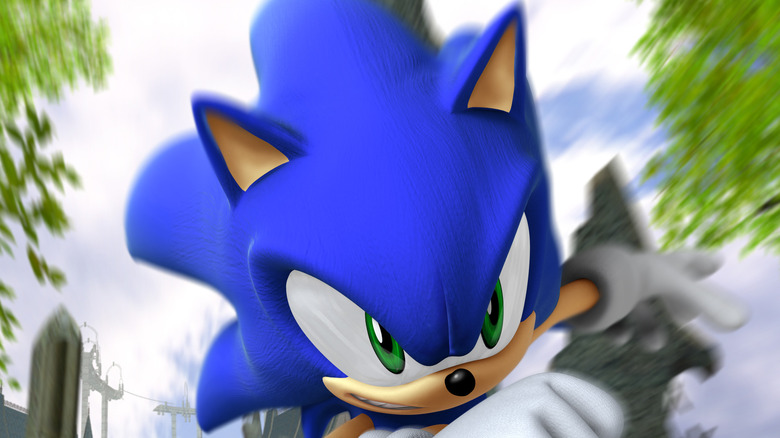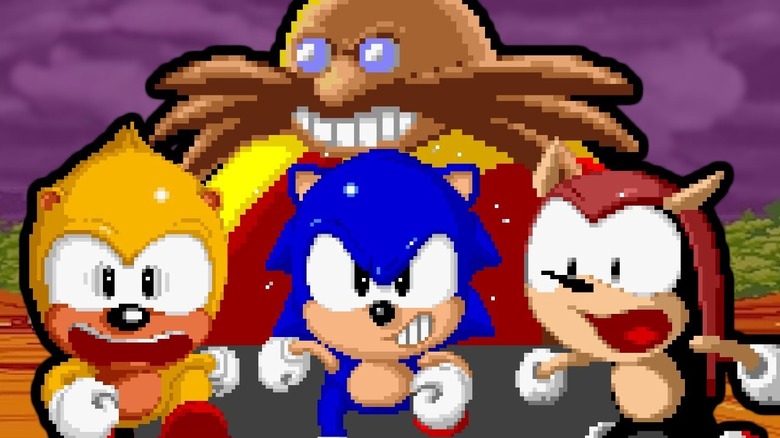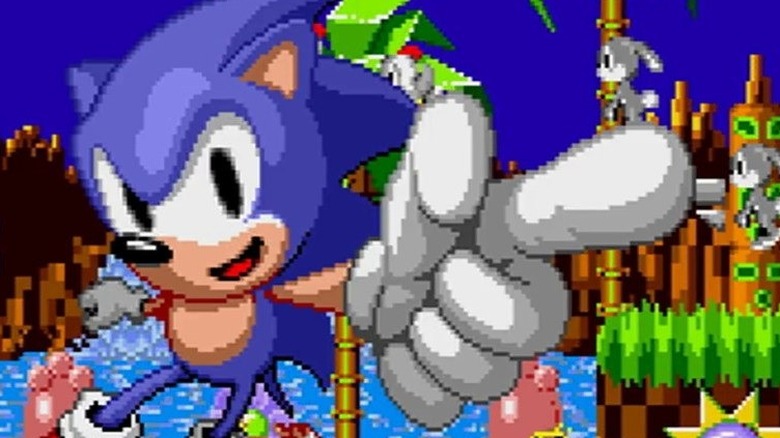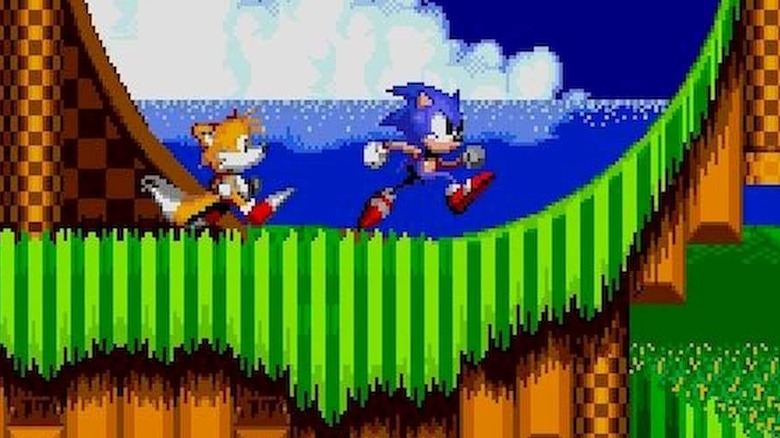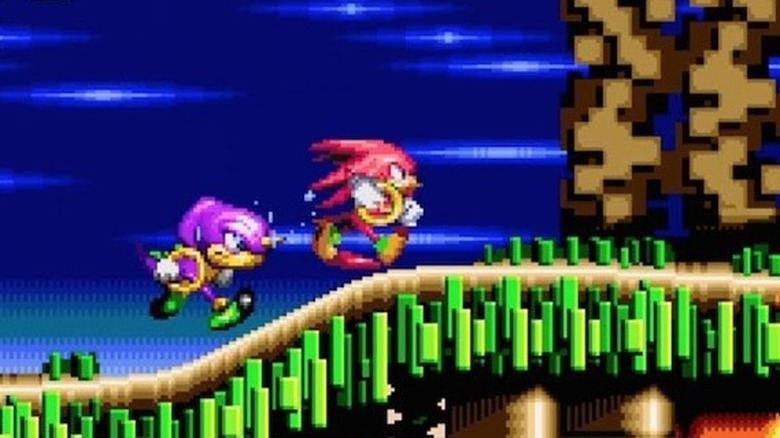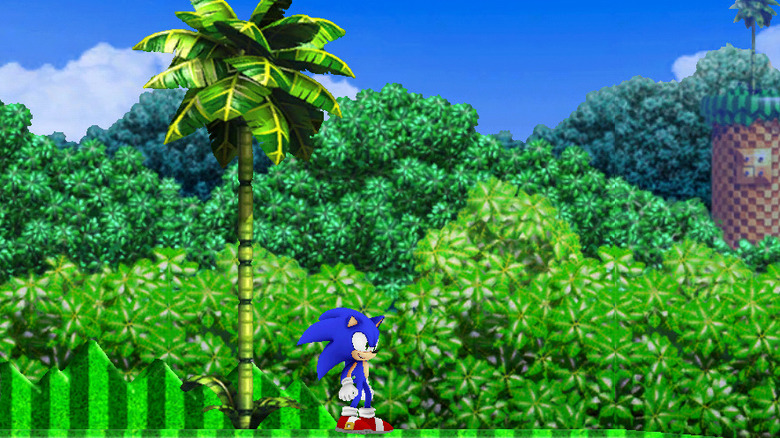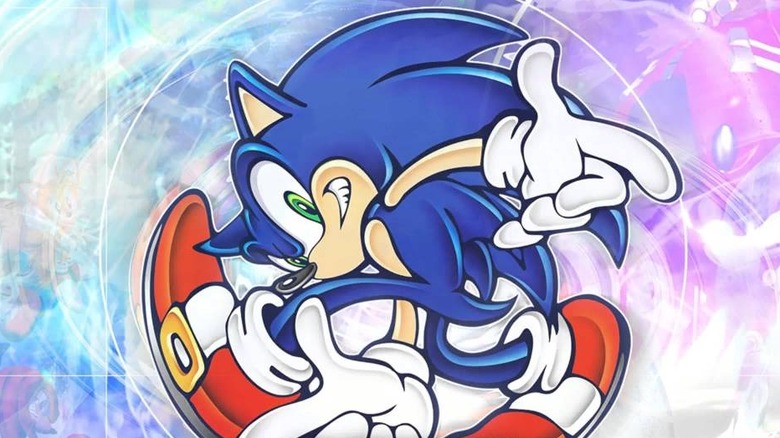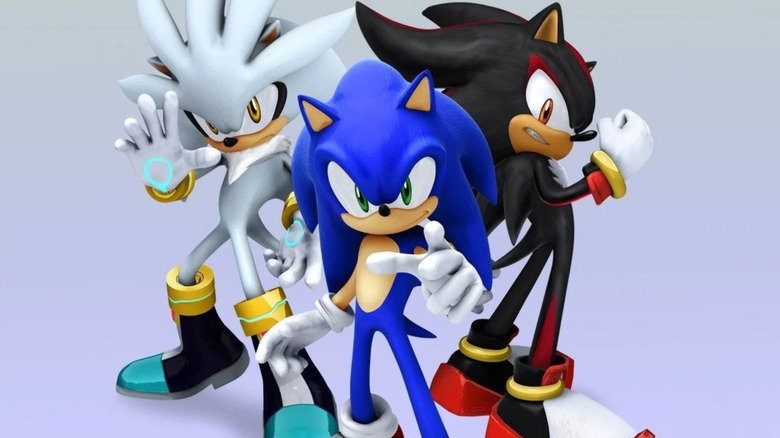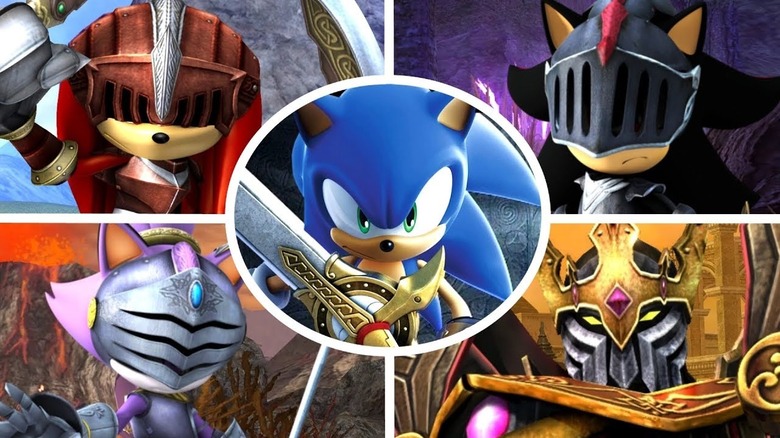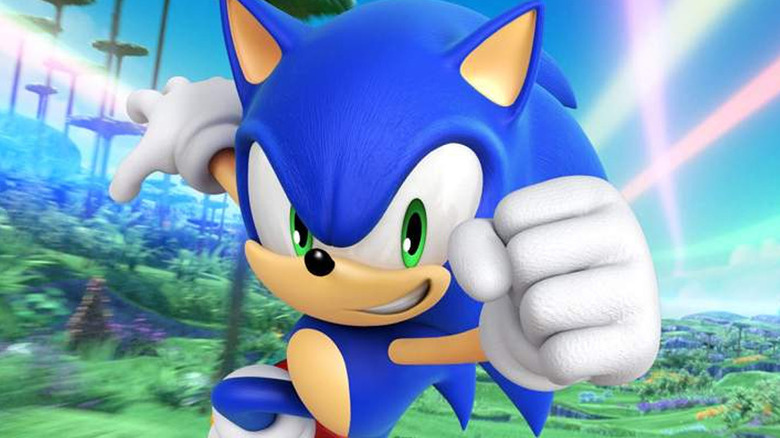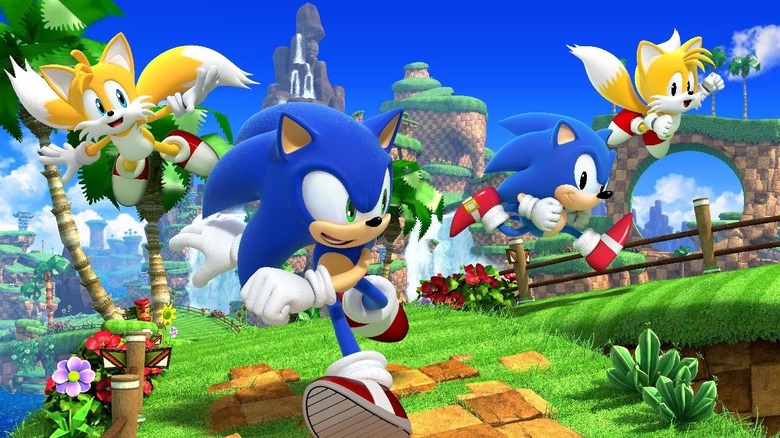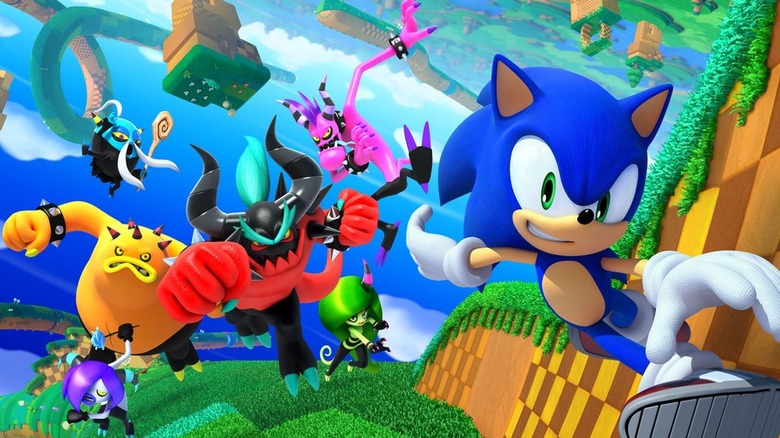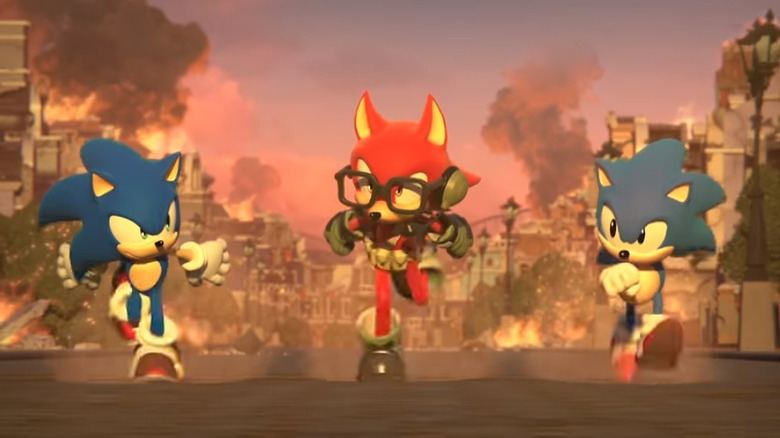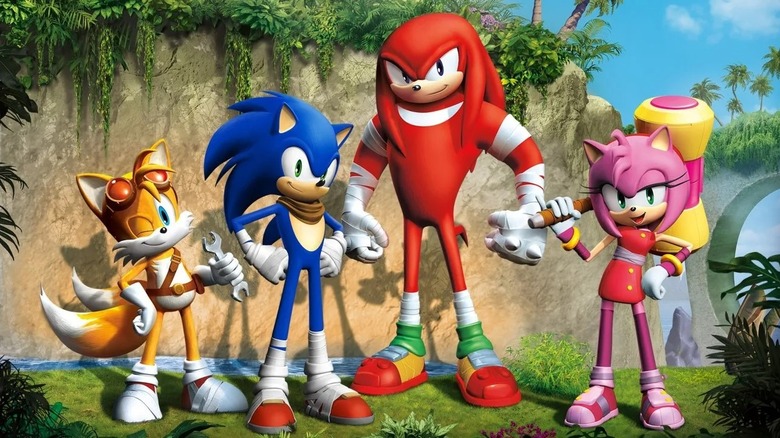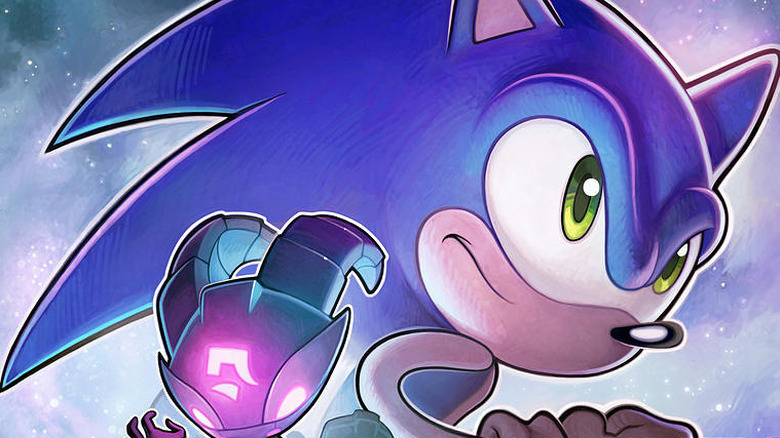The Entire Sonic The Hedgehog Timeline Explained
When it comes to iconic mascots, few characters can compete with Sonic the Hedgehog. Sega is celebrating Sonic's 30th anniversary in June 2021, though TheGamer points out that the blue blur made his first appearance in February 1991. Over the course of the franchise, Sonic has inspired stories in numerous mediums with their own distinct timelines, including a successful and well-reviewed movie, several different cartoons, and various comic book series.
Even brushing these spinoffs aside, understanding the games' core events is a complex endeavor. Sega has yet to release an official timeline, leaving fans to speculate about the precise chronology and canonicity of "Sonic" titles.
In the core series' timeline, Sonic lives on a version of Earth that is similar to our own, with several fantastic exceptions. In addition to humans and Earth's normal continents, anthropomorphic talking animals — like Sonic himself — inhabit a number of fictional islands tucked away in the far reaches of the world. These semi-magical regions house seven gems of unimaginable power, known as Chaos Emeralds, as well as one Master Emerald. A less powerful, but more plentiful (and iconic) resource, Golden Rings, also pervade these fictional regions.
These precious resources eventually attract the attention of Sonic's arch-nemesis, setting the events of the franchise into motion.
Robotnik emerges in SegaSonic the Hedgehog
The evil Dr. Ivo Robotnik, also known as Doctor Eggman, is drawn to the powerful Chaos Emeralds on Christmas Island. Just as Bowser is famous for capturing Princess Peach, Robotnik's primary schtick is transforming animals into robotic enemies called Badniks and attempting to harness the power of the Chaos Emeralds. His goal: to expand his empire and eventually achieve global domination.
Though "Sonic the Hedgehog" for Genesis was the first game released, Reddit users have collaborated on a detailed breakdown of the series' fictional chronology, which suggests that another game may have preceded it. "SegaSonic the Hedgehog," an arcade game released in 1993, seems to chronicle Sonic and friends' first clash with Robotnik.
In "SegaSonic the Hedgehog," Sonic and his allies, Mighty the Armadillo and Ray the Flying Squirrel, are living on Christmas Island when it is invaded by Robotnik. He kidnaps the trio, taking them to Eggman Island, and they must team up to defeat the mad doctor. At the game's climax, Robotnik triggers a self-destruct sequence that will destroy the entire island. Sonic and friends manage to escape, but Robotnik's vehicle runs out of gas and he plummets into the sea.
Sonic the Hedgehog and Sonic CD
Fans have deduced that the next title in the sequence is most likely the 8-bit Game Gear edition of "Sonic the Hedgehog." After driving Robotnik from Christmas Island, Sonic chases him to the neighboring South Island, where the Chaos Emeralds are still scattered in their natural landscape. Sonic collects the gems before Robotnik, and uses their power to trounce the egg-shaped villain.
In the 16-bit "Sonic the Hedgehog" for Genesis, which launched the "Sonic" franchise, the Emeralds have apparently retreated to another dimension to recharge their power, as evidenced by their presence in special stages, rather than the levels proper.
"Sonic the Hedgehog CD" adds a new locale and plot device known as Little Planet; a mysterious planetoid that intermittently appears over Earth in the "Sonic" universe. Rather than Chaos Emeralds, Little Planet houses its own artifacts: the chronology-altering Time Stones. "Sonic CD" also introduces Amy Rose, a pink hedgehog smitten with Sonic who later becomes a major character in the franchise. Additionally, Robotnik creates recurring antagonist Metal Sonic, a robot operative resembling Sonic, who abducts Amy. As per the series' formula, Sonic collects the Time Stones, saves Amy from Metal Sonic, and once again beats Robotnik into retreat.
Sonic 2, Sonic 3, and Sonic & Knuckles
The precise chronology of Miles "Tails" Prower's first adventure, the appropriately-titled Game Gear release "Tails Adventure," is subject to some debate on Reddit. This is due to the fact that the game is either a prequel or sequel, depending on whether you're playing the Japanese or International version of the game.
Regardless, Sonic and Tails first officially team up in "Sonic the Hedgehog 2." In "Sonic 2", Robotnik erects the Death Star-like Death Egg to dominate the world. "Sonic 2" also introduces the Super Sonic ability, wherein Sonic takes a glowing form that is stronger, faster, and semi-invulnerable.
In "Sonic the Hedgehog 3", Sonic encounters Knuckles the Echidna, who goes on to become a major presence in the series. Knuckles' spiked fists allow him to climb walls and glide across levels. Initially, Robotnik tricks Knuckles into battling Sonic, but the two end up working together to defeat the villain.
"Sonic and Knuckles", a lock-on cartridge expansion that allows players to play as Knuckles, features two stories of its own. The first chronicles Sonic's efforts to recover the Master Emerald from Robotnik. Knuckles' story follows, detailing his battles with Mecha Sonic, an upgraded/alternate form of Metal Sonic.
It is also worth noting the handheld (8-bit) version of "Sonic 2" has its own unique story that likely follows "Sonic and Knuckles," as Tails is kidnapped by Robotnik — an event that is not referenced in earlier titles.
Lesser-known Classic Sonic titles
A number of lesser-known titles followed "Sonic and Knuckles" and were released for the Master System, Game Gear, and 32X, rather than the Sega Genesis, which played host to most of the earlier "Sonic" titles. Most of these games do not directly reference each other, with the exception being that "Knuckles Chaotix" mentions the events of "Sonic and Knuckles."
In "Sonic Chaos," Robotnik has stolen a Chaos Emerald, causing South Island to sink into the sea until he is foiled by Sonic and Tails. "Sonic Triple Trouble" features Robotnik and the unique villain Fang the Sniper (also known as "Knack" internationally). It also features Knuckles, who is once again tricked into fighting Sonic. Again, Sonic must conquer his foes and win the day.
Spinoff title "Knuckles Chaotix" sees the echidna and his team of freedom fighters, the Chaotix, battling to stop Robotnik from synthesizing Chaos Rings: an artificial, destructive version of Sonic's normal Gold Rings. This is one of few "Sonic" games to feature multiple endings, though only the "good ending," where Knuckles collects all the Chaos Rings, is considered canonical.
The next titles released chronologically, "Sonic Blast" and "Sonic 3D Blast," are set on Flicky Island, which is populated by dimension-hopping birds called Flickies. Once again, Robotnik steals the Chaos Emeralds, and Sonic, Tails, and Knuckles must save the birds and stop the mad scientist.
Sonic 4 and the End of the Classic Era
Despite being released after many of Sonic's more modern adventures, the episodic "Sonic the Hedgehog 4" was intended to continue in the same spirit of "Sonic the Hedgehog," "Sonic 2," and "Sonic 3." This means that the game's chapters, "Episode 1," "Episode Metal," and "Episode 2," are situated earlier in the franchise's overall timeline.
"Sonic the Hedgehog 4" features a reprisal of many environments and stages from earlier classic "Sonic" titles. "Episode 1" sees Sonic fighting Robotnik solo in his new EGG Station Zone lair. In "Episode Metal," Robotnik revives Metal Sonic, who serves as an anti-hero protagonist and is playable for the first time in Sonic's history. Little Planet also reappears, officially tying "Sonic 4" to the events of "Sonic CD." Robotnik once again attempts to conquer the world with the Death Egg in "Episode 2", only to be defeated by Sonic and Tails working in tandem.
"Sonic 4: Episode 2" appears to be the latest entry in the classic portion of the series' timeline to date.
Modern era 1: Jam's redesign, Adventures, Adventures 2, Heroes, and Shadow the Hedgehog
With "Sonic Jam" for the Sega Saturn, the blue blur received his first makeover by designer Satoshi Okano. In an interview with Fanbyte, Okano explained his desire to leave his mark on Sonic — and his work would eventually lead to yet another iconic redesign.
For his first Dreamcast outing, "Sonic Adventure," Sonic received a slender redesign from Yuji Uekawa. For several years, "Sonic" games followed a straightforward progression in-line with the games' real-world release chronology, with "Sonic Adventure", "Sonic Adventure 2", "Sonic Heroes", and "Shadow the Hedgehog" all following a clear timeline. In this period, "Sonic" games shifted from 2D platforming to more varied, 3D adventure gameplay.
The series also began to feature larger casts of characters, starting with "Sonic Adventure." These different characters also had their own unique storylines and mechanics, widening the scope of what the series could offer players. For instance, Big the Cat's "Sonic Adventure" levels were all based around fishing.
The theme of "Sonic Adventure 2" was good versus evil, and it featured the videogame debut of both Rouge the Bat and Shadow the Hedgehog, a new, anti-hero rival for Sonic. The latter character proved popular enough to star in his own game, which introduced firearms to the franchise formula.
It is also worth noting that Sega released the "Sonic Advance" handheld series during this same time period, which were 2D platformers that featured Sonic's modernized look.
Errata: Sonic the Hedgehog (2006)
With a metacritic rating of 49, "Sonic the Hedgehog (2006)" is widely considered to be the nadir of the "Sonic" franchise. VGU has noted that it marked the start of a period of critical and commercial decline for Sega's popular mascot. "Sonic 2006" suffers from a number of technical and narrative problems, including glitches, an uncooperative camera, and an uncomfortable romance plot.
The game's story revolves around the human Princess Elise, and features three different lead characters, each with their own "episodes," followed by a final episode starring Sonic. One of the most infamous sticking points for "Sonic (2006)" is that the game narratively invalidates itself, with a final ending that results in a retcon. After Sonic defeats the final boss, Solaris, he and Elise travel back in time and prevent the enemy from coming into existence. In the process, the preceding events are erased from Sonic's continuity — meaning that basically, none of it mattered.
The game's story does feature a few notable milestones for the franchise's timeline, however. It could be considered a foreshadowing of future titles, due to the plot's pronounced time-travel elements and the arrival of a new ally: Silver the Hedgehog, a telekinetic hero from 200 years in the future, who would go on to appear in later games.
Modern era 2: 'The Dark Ages' and Sonic Colors
On home consoles, "Sonic (2006)" was followed by a trio of games: "Sonic and the Secret Rings," "Sonic Unleashed," and "Sonic and the Black Knight." Some critics and fans have referred to this period as Sonic's "Dark Ages." Even though "Rings," "Unleashed," and "Black Knight" are more highly regarded on Metacritic than "Sonic (2006)," Sega's attempts to revitalize Sonic's appeal included adding a number of new mechanics to try to spice up the core 3D adventuring formula.
"Rings" is set in the storybook world of the Arabian Nights, and features an experience point system, as well as linear, on-rails movement. "Unleashed" featured granted Sonic the ability to change into a werewolf/hedgehog hybrid at night. "Black Knight" was influenced by Arthurian myths, introducing swordplay and collectible items to the mix. Because "Rings" and "Black Knight" are both set in fictional parallel universes, they are occasionally referred to as the "Sonic Storybook Series" within the fandom, and it is unclear if they are part of the series' main continuity.
Handheld "Sonic" games from this period, including "Sonic Rivals 1," "Sonic Rivals 2," "Sonic Rush," and "Sonic Rush Adventure," were much lighter on story and saw better reception than the experimental "Storybook" games.
Sonic Colors Redeems the Franchise
The series eventually redeemed itself in the eyes of critics and fans with the release of "Sonic Colors," which was seen as a return to form. In "Colors," Eggman has built an interstellar amusement park which serves as a cover for his usual plans of conquest. Rather than targeting Earth, however, the bad doctor is conquering a colorful alien race known as Wisps. "Colors" also introduces Cubot and Orbot; Eggman's robot sidekicks who act as comic relief, and Yacker, a special White Wisp who asks Sonic and Tails to help free his people from Eggman.
The game introduced the innovative Color Powers mechanic, which allowed for a greater variety of gameplay. By partnering up with Wisps, the playable character gains access to situational power-ups that allow for unique methods of traversing levels or defeating opponents. Wisps themselves, cute creatures from the planet Wisp (naturally), are visually and thematically similar to the Chao characters featured in "Sonic Adventure" titles, but they are their own distinct species.
Classic and Modern Sonic converge in Sonic Generations
The return to Sonic's roots that "Colors" represented proved popular, and so Sega continued the trend of revering the series' beginnings with "Sonic Generations." Developed in part of a tribute to the character's 20th anniversary, "Generations" is notable for the fact that Sonic's original design makes his first appearance as a distinct character in the series' modern era. The game's levels also combined the past and the present and featured a mix of 2-dimensional platforming and linear 3D platforming, with both styles of gameplay focused on the series' signature element of speed.
"Generations" has a diminished emphasis on the sheer number of playable characters in the game, though it does feature a signature villain who appears later in the franchise: the Time Eater. Thanks to time traveling shenanigans, Dr. Eggman and Classic Eggman (originally known as Dr. Robotnik) team up with each other. The pair of evil geniuses attempt to use the Time Eater as a weapon to alter history, turning their past attempts at world domination into successes. However, the Time Eater breaks free from Eggman's influence and nearly destroys him in the process, leaving it up to both Sonics to save the day.
Modern era 3: Sonic Lost World
"Sonic: Lost World" was the final entry in the blue blur's modern era before two back-to-back timeline-convergence titles. "Lost World" borrowed several elements from "Sonic Colors," including the Wisp-fueled Color Power system. Additionally, the game also featured a mix of 2D and 3D levels, similar to "Sonic Generations." "Lost World" also incorporated a new parkour-inspired movement system to help new Sonic players achieve a kind of satisfying flow through levels — a mechanic that would be revisited in later games.
In terms of narrative, the titular lost world is a floating continent known as Lost Hex. On this island in the sky, Sonic and friends must once again defeat Eggman, who has enslaved the Deadly Six, a group of demonic creatures known as Zeti, who serve as the game's unique antagonists.
"Lost World" did not introduce any new playable characters into the mix, but it did feature an interesting suite of mini-games in which players could control RC vehicles. These mini-games allowed for cross-play between the Wii U and 3DS versions of the game.
Second convergence: Sonic Mania, Sonic Forces
The last chronological entries in the primary "Sonic" universe, both "Sonic Mania" and "Sonic Forces" see Classic Sonic once again jumping to the series' present to help Modern Sonic.
"Sonic Mania" is unique among the convergence titles, however, in that Classic Sonic's disappearance at the end of game is situated directly after the events of "Sonic and Knuckles," and the game's ending segues directly into "Forces." "Mania" was once again a side scrolling 2D platformer designed to evoke the classic era, and featured many contributions from Sonic's considerable fandom, which gave the game a much-needed feeling of authenticity.
In contrast, "Sonic Forces," currently the last title in the main "Sonic" series' chronology, was an adventure game/platformer hybrid in the spirit of modern titles, though it also catered to fans in a unique way. In "Forces," players could create their own Sonic-style avatar, dubbed "The Rookie," who would team up with franchise-favorite characters to oppose Eggman.
Though "Forces" was advertised as a completely new experience that is not a sequel to any prior Sonic title, the cast is composed of characters from prior titles, with histories and relationships that are consistent with the rest of the modern timeline. Also, the point at which Sonic vanishes from the Classic era in the secret ending of "Sonic Mania" strongly implies that "Forces" is meant to be a follow-up to that title.
The Sonic Boom Universe
One of Sega's attempts to revivify and modernize Sonic's image in the mid 2010s was a franchise concept titled "Sonic Boom." A trio of video games for the Nintendo 3DS and Wii-U were accompanied by a CGI-animated television series of the same name. Sonic and his allies received overhauled designs for this alternate universe, with everyone getting a more rugged appearance.
The "Boom" series was designed with a greater emphasis on exploration and battling, rather than speed and platforming. Like "Shadow the Hedgehog," the games also featured weaponry that players could use in addition to standard melee combat. The series' signature item, "the Enerbeam," allowed players to interact with the environment to solve puzzles and defeat certain enemies. The series also introduced Sticks the Badger, a character exclusive to the "Boom" universe, who aided Team Sonic with boomerangs in their battles against Eggman.
Despite the familiar premise of Sonic heroically leading a resistance against the forces of Eggman, as well as appearances of other staple antagonists like Shadow and Metal Sonic, the "Boom" universe does not crossover other "Sonic" titles.
Other Errata and Spinoffs
Like "Sonic 2006," there are numerous other games that do not fit into the "Boom" universe, or either phase of the main "Sonic" timeline without some speculative interpretation on behalf of the player.
The franchise has branched out into a number of spinoff titles, with varying mechanics such as "Sonic Spinball" (a platforming/pinball hybrid), "Sonic the Fighters" (a fighting game, naturally), the "Mario & Sonic" series (Olympic-themed mini-game compilations) and a number of edutainment and racing games. These titles make no specific references that could situate their place in Sonic's chronology, save for Sonic's character design.
A handheld RPG developed by Bioware, "Sonic Chronicles: The Dark Brotherhood," also arguably falls into the category of de-canonized games, or perhaps a separate continuity unto itself. Despite being moderately well-received by players and critics and closing on a cliffhanger, the game never received a sequel, even though Redditors have theorized that a story was already written before the sequel's cancellation.

